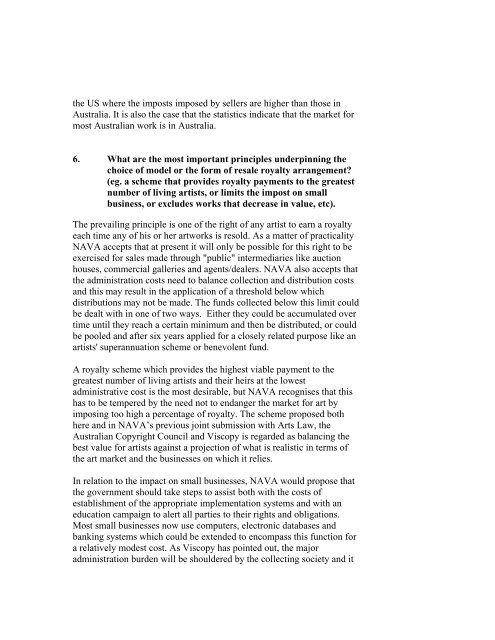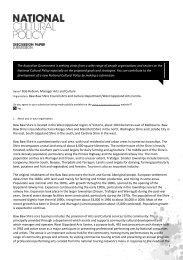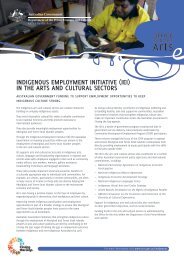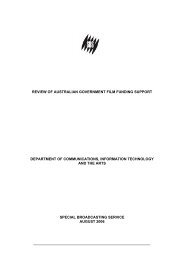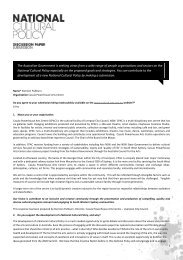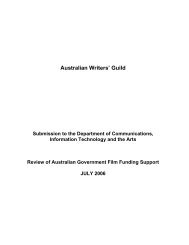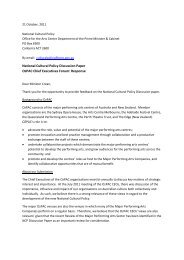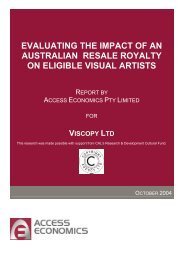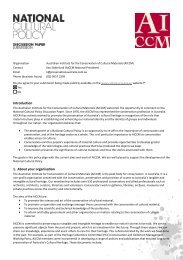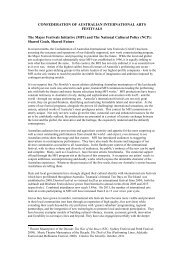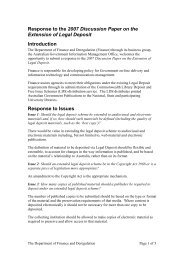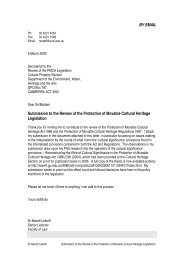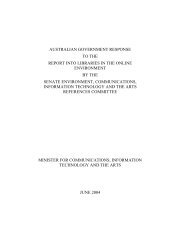National Association for the Visual Arts
National Association for the Visual Arts
National Association for the Visual Arts
Create successful ePaper yourself
Turn your PDF publications into a flip-book with our unique Google optimized e-Paper software.
<strong>the</strong> US where <strong>the</strong> imposts imposed by sellers are higher than those inAustralia. It is also <strong>the</strong> case that <strong>the</strong> statistics indicate that <strong>the</strong> market <strong>for</strong>most Australian work is in Australia.6. What are <strong>the</strong> most important principles underpinning <strong>the</strong>choice of model or <strong>the</strong> <strong>for</strong>m of resale royalty arrangement?(eg. a scheme that provides royalty payments to <strong>the</strong> greatestnumber of living artists, or limits <strong>the</strong> impost on smallbusiness, or excludes works that decrease in value, etc).The prevailing principle is one of <strong>the</strong> right of any artist to earn a royaltyeach time any of his or her artworks is resold. As a matter of practicalityNAVA accepts that at present it will only be possible <strong>for</strong> this right to beexercised <strong>for</strong> sales made through "public" intermediaries like auctionhouses, commercial galleries and agents/dealers. NAVA also accepts that<strong>the</strong> administration costs need to balance collection and distribution costsand this may result in <strong>the</strong> application of a threshold below whichdistributions may not be made. The funds collected below this limit couldbe dealt with in one of two ways. Ei<strong>the</strong>r <strong>the</strong>y could be accumulated overtime until <strong>the</strong>y reach a certain minimum and <strong>the</strong>n be distributed, or couldbe pooled and after six years applied <strong>for</strong> a closely related purpose like anartists' superannuation scheme or benevolent fund.A royalty scheme which provides <strong>the</strong> highest viable payment to <strong>the</strong>greatest number of living artists and <strong>the</strong>ir heirs at <strong>the</strong> lowestadministrative cost is <strong>the</strong> most desirable, but NAVA recognises that thishas to be tempered by <strong>the</strong> need not to endanger <strong>the</strong> market <strong>for</strong> art byimposing too high a percentage of royalty. The scheme proposed bothhere and in NAVA’s previous joint submission with <strong>Arts</strong> Law, <strong>the</strong>Australian Copyright Council and Viscopy is regarded as balancing <strong>the</strong>best value <strong>for</strong> artists against a projection of what is realistic in terms of<strong>the</strong> art market and <strong>the</strong> businesses on which it relies.In relation to <strong>the</strong> impact on small businesses, NAVA would propose that<strong>the</strong> government should take steps to assist both with <strong>the</strong> costs ofestablishment of <strong>the</strong> appropriate implementation systems and with aneducation campaign to alert all parties to <strong>the</strong>ir rights and obligations.Most small businesses now use computers, electronic databases andbanking systems which could be extended to encompass this function <strong>for</strong>a relatively modest cost. As Viscopy has pointed out, <strong>the</strong> majoradministration burden will be shouldered by <strong>the</strong> collecting society and it


